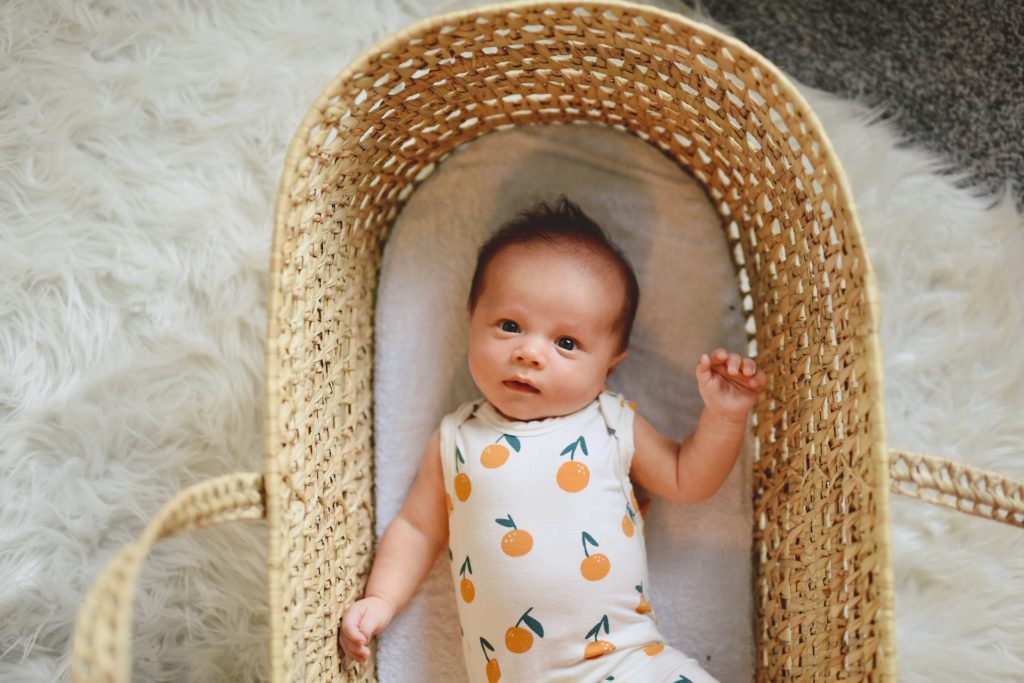There are a lot of different opinions on how long can a baby sleep in a bassinet. My babies were in there about four months.
Some people say it is safe for a baby to sleep in a bassinet until they are six months old, while others say it is only safe for them to sleep in a bassinet until they are three months old. So, what is the truth?
How long can a baby safely sleep in a bassinet?
Table of Contents
- How Long Can A Baby Sleep In A Bassinet?
- Here Are Some Reasons For Making The Switch To A Crib
- Final Thoughts By Sharon
Newborns and very young babies (between two and four months) sleep most comfortably in bassinets. They feature higher sides to keep infants secure and some even have canopies or mosquito nets to keep the bugs away. In the first few months, when parents just want to keep an eye on their newborn, a bassinet may be transported from room to room with ease.

Added storage space is a convenient feature of many bassinets, allowing parents to keep diapers, wipes, and other necessities within easy reach. It may be a suitable choice for parents with a small nursery because it takes up less room than a standard crib.
How Long Can A Baby Sleep In A Bassinet?
It’s a great deal when a baby can start sleeping through the night on its own. In many ways, this is the start of a brand new phase in their growth. By six months of age, your baby should have outgrown the bassinet, as recommended by the American Academy of Pediatrics. The AAP also advises parents to have their children share a bedroom for at least six months “because it can cut the incidence of SIDS by as much as 50%.”
If you decide to engage in sleep training for your infant, you should consider transferring them into their room when they are four months old. This will ensure that they are unable to see you after you have placed them on their backs in a secure position. Babies who sleep in their rooms tend to sleep for longer stretches, remain calmer throughout the night, and experience a greater sense of security.
It is common practice to move a baby into a crib between the ages of 3 and 6 months. It may not be necessary to rush into the transfer to a crib if your baby is still sleeping soundly in the bassinet. However, the greater the delay, the greater the likelihood of infant resistance. Here are some benefits that a bassinet can do for your baby’s sleep:
- Bassinets promote better sleep for babies.
- Bassinets reduce the risk of SIDS.
- Bassinets are easier on parents’ backs.
- Bassinets promote bonding between parent and child.
- Bassinets are portable.
Here Are Some Reasons For Making The Switch To A Crib

You may be wondering when the time is right to switch your baby from a bassinet to a crib. Now, then, let’s talk about some guidelines for making that change.
Many parents contact me to ask this question. “So Sharon, can you talk about when is the right time to move to a crib?” So let’s get to it!
1. The Bassinet Is Now Too Little For Your Baby.
Bassinets are designed for newborns and infants up to about 4 months old. If your baby is starting to look cramped in the bassinet or seems uncomfortable, it’s probably time to switch to a larger sleeping space.
A crib will provide more space for your growing child and will last until they’re ready for a toddler bed, which is usually around 2-3 years old. Making the transition from bassinet to the crib can be a big adjustment for both you and your baby, but it’s important to do it when the time is right.
2. Your Baby Is Rolling Over Frequently
If your baby is starting to roll around a lot, it’s time to move to a crib where he or she will have more room to move around safely. That’s because they become more active and need more space to wiggle around. They can also start to sit up on their own around this time. If your baby is rolling over or sitting up unassisted, it’s time for a crib.
Cribs are sturdier than bassinets, so they can handle a lot of movement from your baby. They’re also larger, so your baby will have plenty of room to grow. When you’re ready to make the switch, try putting your baby in the crib for short periods at first, so he or she can get used to the new surroundings.
3. You Have Trouble Cleaning The Bassinet.
As your baby starts to eat solid foods and produce more diapers, you’ll likely find yourself needing to wash the bassinet sheets more frequently. A crib will be easier to keep clean since you can simply remove the mattress and wash it as needed. The removable mattress also makes it easier to change your baby’s crib sheets.
In addition, a crib will provide your baby with more room to grow. When your baby outgrows a bassinet, you’ll need to purchase a new one. A crib, on the other hand, can be used for several years.
4. You’re Ready For Some Independence Back In Your Life!
If you’re finding that you’re spending all of your time tending to your baby in the bassinet, it might be time for both of you to have some more space. Moving your baby into a crib will give you some much-needed freedom and allow you both to get some rest! Additionally, cribs are typically taller than bassinets, which means that you won’t have to bend over as much to pick up your baby or put them down for a nap.
Final Thoughts By Sharon
Babies can use bassinets for the first few months of their lives, but they will eventually need to transition to a crib. In most cases, infants outgrow their bassinets between the ages of three and six months. This change typically occurs when the infant can roll over or sit up unassisted. Because of the baby’s increasing mobility, the crib’s side rails should be removed.
Talk to your baby’s pediatrician if you have any doubts about when he or she is ready to transition to a crib. They will be able to guide you based on your baby’s specific growth.
Thanks!
Sharon











